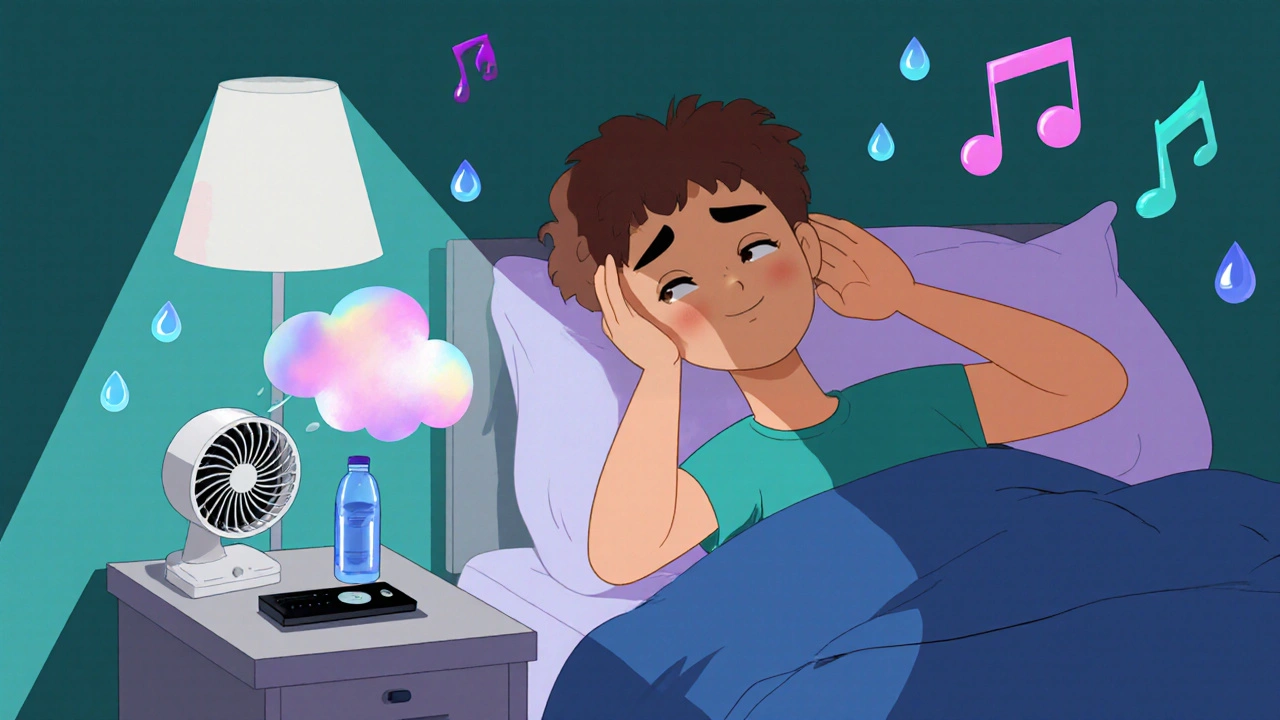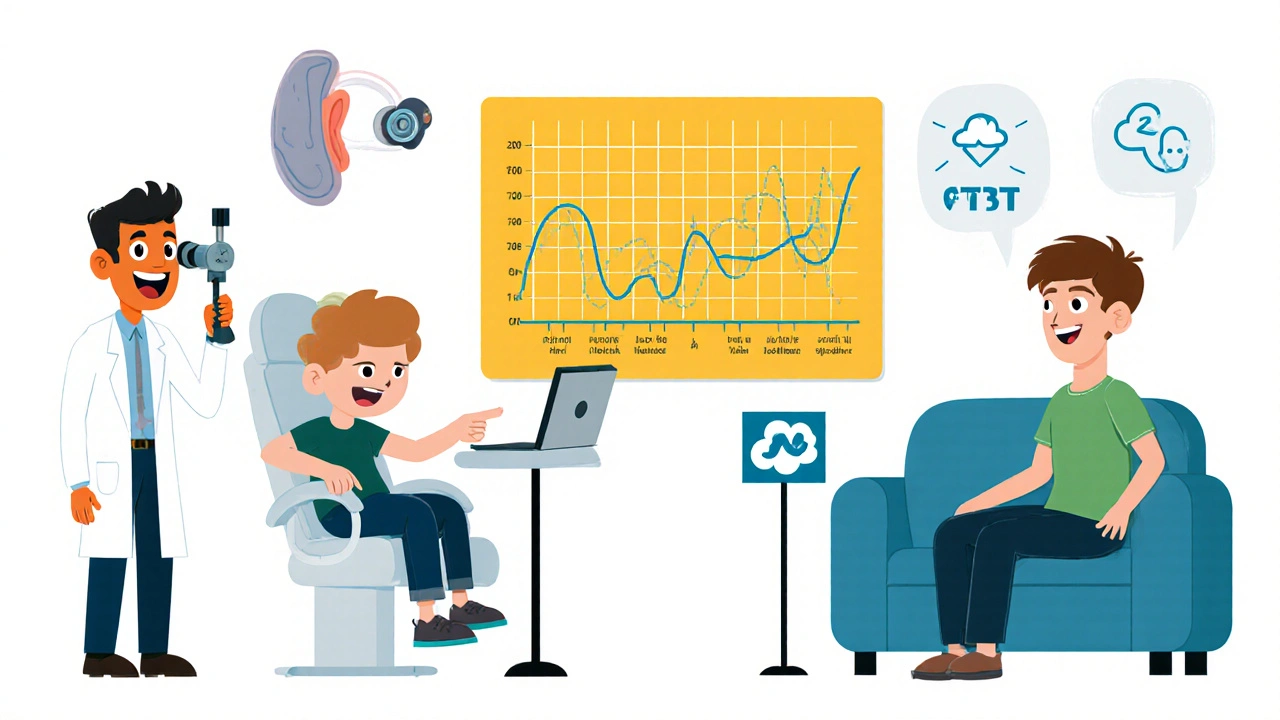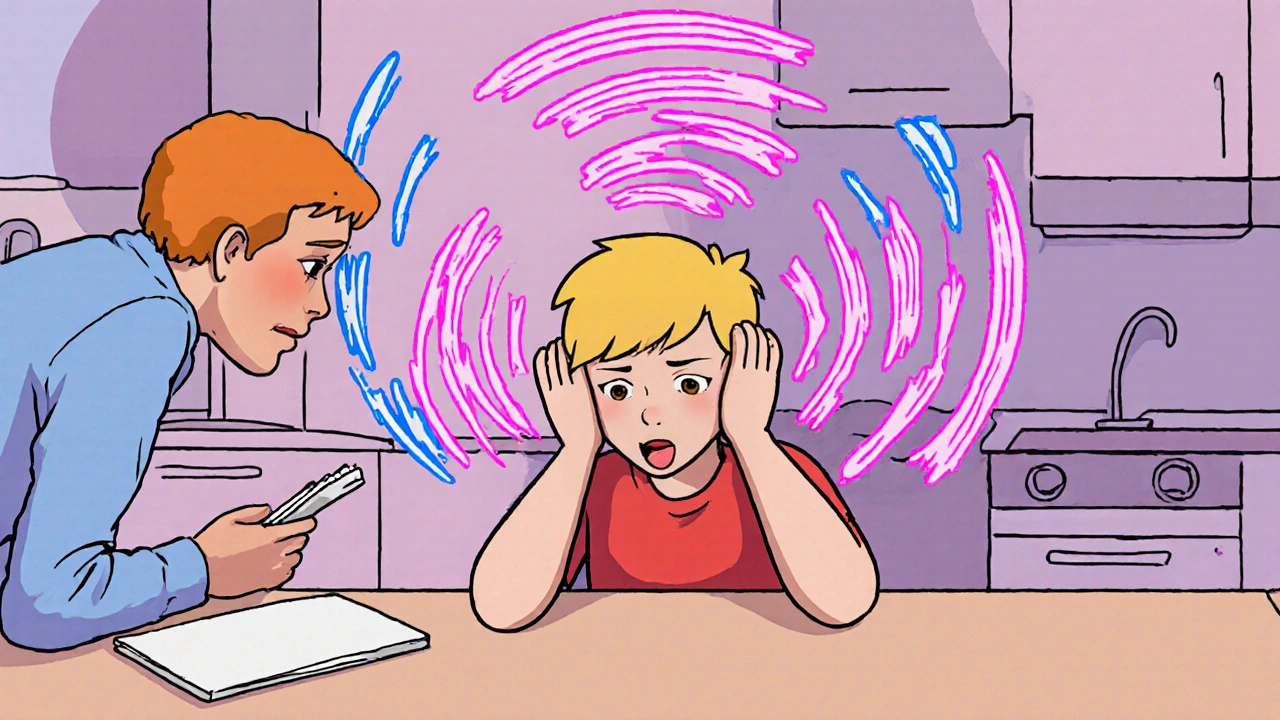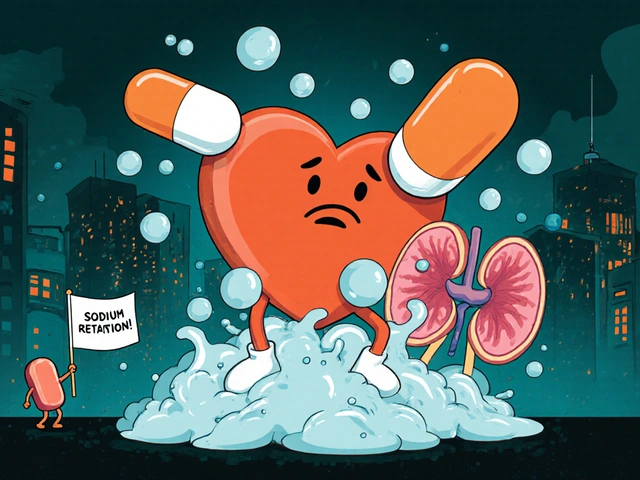Tinnitus Assessment Tool for Kids and Teens
Assess Your Child's Tinnitus
Assessment Results
Your child's tinnitus symptoms will be evaluated based on the information provided. Results will appear here after assessment.
When a child or teenager complains about a constant "ringing" in their ears, parents often feel helpless. That persistent sound-known medically as Tinnitus is the perception of sound without an external source, commonly described as ringing, buzzing, or hissing-can be frightening, especially when it shows up during a homework session or a night of sleep. Below you’ll find a step‑by‑step guide to figure out what’s causing the noise, how to ease it, and when to call in a professional.
Why Kids Experience Tinnitus
Unlike adults, children don’t always articulate the problem clearly, but a few common triggers show up repeatedly:
- Ear infections - Fluid buildup can affect the tiny hair cells in the inner ear.
- Exposure to loud music or video games (noise‑induced hearing loss).
- Ototoxic medications such as certain antibiotics or chemotherapy drugs.
- Stress and anxiety, which amplify the brain’s focus on internal sounds.
- Underlying medical conditions like auditory processing disorder or congenital ear malformations.
Knowing the likely culprit helps you target the right solution.
Step 1: Take a Quick Self‑Check at Home
- Ask your child to describe the sound. Is it high‑pitched, low‑rumbling, constant, or intermittent?
- Check for recent loud events-concerts, fireworks, or amplified headphones.
- Review any medicines taken in the past month.
- Look for signs of infection: ear pain, fever, or fluid draining.
- Notice if stressors (school exams, bullying) have increased.
Write down your observations. A simple notebook can become a valuable reference for the ENT doctor.
Step 2: Simple Home Remedies That Often Work
Before you schedule an appointment, try these low‑risk strategies. Most are backed by pediatric audiology research and have minimal side effects.
- White‑noise background: A fan, soft music, or a white‑noise app can mask the ringing and help your child fall asleep.
- Gentle ear massage: Move the tragus (the small protrusion in front of the ear canal) in small circles for a minute. This can improve blood flow and reduce perception of the sound.
- Hydration: Dehydration sometimes intensifies tinnitus, so keep your teen sipping water throughout the day.
- Limit caffeine and sugary drinks, which can heighten auditory sensitivity.
- Protect ears from future noise: Encourage volume limits on headphones (no louder than 60 % of maximum) and use earplugs at loud events.

Step 3: When to Seek Professional Help
If the ringing lasts longer than two weeks, worsens, or is accompanied by hearing loss, dizziness, or balance issues, it’s time to see a specialist. Here’s what to expect:
- ENT (Ear, Nose, Throat) specialist: Will examine the ear canal, perform an otoscopic inspection, and order imaging if needed.
- Audiologist: Conducts an Audiogram is a graph that records hearing thresholds across frequencies, helping pinpoint the type and severity of hearing loss and may run a tympanometry test to assess middle‑ear function.
- Potential referral to a pediatric neurologist if neurological causes are suspected.
Bring your observation notebook, a list of medicines, and a summary of recent noise exposure to the appointment.
Step 4: Treatment Options Approved for Kids
Once a cause is identified, treatment can be tailored. Below is a quick‑reference table that outlines the most common interventions, their typical usage, and what families report as the biggest benefit.
| Intervention | When Used | Key Benefit | Typical Duration |
|---|---|---|---|
| Sound therapy (white‑noise machines) | General tinnitus, no hearing loss | Immediate masking of ringing | Continuous, nightly use |
| Cognitive Behavioral Therapy (CBT) | Stress‑related or chronic tinnitus | Reduces anxiety and perceived loudness | 6‑12 weekly sessions |
| Hearing aids | Co‑existing hearing loss | Amplifies external sounds, making tinnitus less noticeable | As needed, lifelong |
| Medication review | Suspected ototoxic drugs | Eliminates drug‑induced trigger | Variable; often short‑term |
| Ear protection education | Noise‑induced cases | Prevents worsening or new episodes | Ongoing habit formation |
Most children respond well to a combination of sound therapy and CBT, especially when stress is a major factor. Hearing aids are less common but can be life‑changing for those with concurrent hearing loss.

Step 5: Lifestyle Tweaks for Long‑Term Relief
Even after treatment, a few day‑to‑day habits keep the ringing at bay:
- Maintain a regular sleep schedule; poor sleep intensifies tinnitus perception.
- Encourage physical activity-exercise improves blood flow to the inner ear.
- Teach relaxation techniques such as deep breathing, progressive muscle relaxation, or guided imagery.
- Schedule “quiet times” where screens are off and ambient noise is low, giving the auditory system a break.
Consistency is key; habits built now can prevent future episodes during the teenage years.
Quick Takeaways
- Identify the cause: infection, noise, medication, or stress.
- Start with home strategies: white‑noise, ear protection, hydration.
- Seek an ENT specialist if symptoms persist beyond two weeks or worsen.
- Evidence‑based treatments include sound therapy, CBT, and hearing aids when needed.
- Healthy sleep, exercise, and stress‑relief routines protect against recurrence.
Frequently Asked Questions
Can headphones cause tinnitus in kids?
Yes. Listening at high volume for extended periods can damage the delicate hair cells in the inner ear, leading to permanent ringing. The American Academy of Pediatrics recommends keeping volume below 60 % of maximum and limiting listening sessions to 60 minutes per day.
Is tinnitus ever a sign of a serious disease?
Rarely, but it can indicate conditions such as Meniere’s disease, acoustic neuroma, or severe infection. That’s why persistent ringing that lasts more than a few weeks should be evaluated by an ENT specialist.
Can diet affect tinnitus?
Some studies link high‑sodium or high‑sugar diets to increased tinnitus perception. Reducing salty snacks and sugary drinks may help, especially if the child is also prone to hypertension or diabetes.
What is the role of an audiologist in managing pediatric tinnitus?
An audiologist conducts detailed hearing assessments, recommends hearing aids if needed, and can fit sound‑masking devices. They also guide families on ear‑health best practices.
Is there any medication that can cure tinnitus?
Currently, no drug fully eliminates tinnitus. Treatments focus on managing the perception-such as antidepressants for severe anxiety or certain anticonvulsants in specific cases-under specialist supervision.
Managing ringing in the ears children isn’t about a quick fix; it’s a blend of pinpointing the cause, applying evidence‑based therapies, and building lifelong ear‑healthy habits. With the right approach, most kids regain quiet nights and clear focus for school, sports, and everything in between.







Comments
Sireesh Kumar
October 22, 2025 AT 17:00 PMAlright, let me break this down for anyone who’s feeling lost – children’s ears are delicate, and the ringing you hear isn’t just “in their heads”. First, rule out an infection; fluid can literally bounce sound around the inner ear, making it feel like a constant alarm. Then, check any recent loud concerts, gaming marathons, or headphone sessions – even a few minutes at max volume can set off a chain reaction. Medications matter too; some antibiotics and chemo agents are notorious ototoxic villains. Stress is a sneaky culprit, especially during exams or bullying, amplifying the brain’s focus on that phantom noise. Once the cause is narrowed, start simple: white‑noise fans or apps to mask the tone, gentle ear massages to boost circulation, and keep the kid hydrated. Cut down caffeine and sugary drinks – they can flick the volume up on the inner ear’s sensitivity. Finally, if the ringing hangs on past two weeks or comes with dizziness, it’s time to see an ENT or audiologist. Trust the process, and you’ll likely see the ringing fade into the background.
cariletta jones
October 22, 2025 AT 19:20 PMGreat summary! Your step‑by‑step guide makes it easy for parents to act quickly and keep kids safe.
Kevin Hylant
October 22, 2025 AT 20:43 PMCheck the meds list first – if any ototoxic drugs are there, stop them and call the doctor.
Marrisa Moccasin
October 22, 2025 AT 22:06 PMWow!!! So many "facts" here... but have you considered that the government might be using tinnitus‑inducing frequencies in school Wi‑Fi?!!!??!!
Just saying, stay alert!!!
Eileen Peck
October 22, 2025 AT 23:30 PMi think the part about hydration is super important – kids forget to drink water when they’re busy with schoolwork. also, ear massages can feel a bit weird for them, so show them how to do it gently. remember to keep the volume low on earbuds – 60% max is a good rule. if you notice any fluid draining from the ear, thats a sign of infection and you should see a doctor pronto. hope this helps!!
Vandermolen Willis
October 23, 2025 AT 00:53 AM👍 Nice rundown! Adding a few emojis can make the advice feel more friendly 😊. White‑noise fans are a lifesaver, and keeping a water bottle handy is a simple habit that works wonders. Keep up the good work! 🎧💤
Ben Collins
October 23, 2025 AT 02:16 AMOh sure, because we all have endless time to sit down and whisper sweet nothings to our kids' ear canals. Maybe try a simple volume limit instead of a full‑blown therapy session.
Denver Bright
October 23, 2025 AT 03:40 AMJust a heads‑up, some of those “experts” might be pushing products that monitor your thoughts via the tinnitus signal. Not saying it’s true, but you never know.
Oliver Johnson
October 23, 2025 AT 05:03 AMLook, I’ve seen a million kids “recover” after they finally stop using earbuds. The real issue is cultural – we glorify loud music as status. If we don’t change that mindset, we’ll keep feeding the tinnitus epidemic.
Taylor Haven
October 23, 2025 AT 06:26 AMFirst, let me say that the very notion of “tinnitus” being a benign nuisance is a dangerous myth propagated by those who profit from pharmaceutical loopholes. It is not merely a harmless ringing; it is a reminder that our bodies are broadcasting distress signals, repeatedly ignored by an over‑busy society that prefers to mute the inconvenient truths. The moment a child reports a persistent hum, we should view it as a warning bell, not a trivial inconvenience to be brushed aside with a fan. Consider the cumulative impact on a developing brain – constant auditory intrusion can reshape neural pathways, leading to heightened anxiety, attention deficits, and even long‑term mood disorders. Yet, the mainstream medical narrative, bolstered by big‑pharma, continues to downplay these ramifications, offering only superficial “masking” solutions like white‑noise machines. Why? Because true treatment would require addressing lifestyle, environmental noise pollution, and the indiscriminate use of ototoxic medications that are often prescribed without sufficient scrutiny. Moreover, the cultural pressure to constantly be plugged in – through earbuds, gaming headsets, and relentless streaming – serves as a fertile breeding ground for this condition. It is not a coincidence that the rise in pediatric tinnitus mirrors the explosion of personal audio device usage. The responsibility deliberately shifts from individual vigilance to collective complacency, and public health policies lag far behind, failing to enforce stricter volume regulations in schools or at public venues. While the post rightly suggests a step‑by‑step troubleshooting guide, it glosses over the systemic changes needed, such as advocating for stricter standards on safe listening levels and demanding transparency from manufacturers about the acoustic emissions of their devices. In addition, the emotional toll on families is understated; the relentless stress of watching a child struggle with phantom sounds can erode familial bonds and lead to burnout. This is why a multidisciplinary approach – involving audiologists, psychologists, educators, and policymakers – is indispensable. The narrative should not end at “see an ENT if it lasts more than two weeks”. It should begin with an urgent call to action: demand better regulation, educate communities, and empower parents with knowledge that transcends simple tips. Until we address the root causes, we will continue to treat symptoms rather than prevent them. In short, tinnitus in children is a public health issue masquerading as an individual complaint, and we must elevate the conversation from passive acceptance to active prevention.
Gary Marks
October 23, 2025 AT 07:50 AMAlright, let’s wade through the sea of half‑baked advice and surface with something that actually sparkles. First off, the whole “white‑noise it away” mantra is cool in theory but half the time parents just crank up a fan and call it a day, forgetting that proper sound therapy involves calibrated frequencies tuned to the child’s specific tinnitus profile – a nuance most commercial devices ignore. Second, the article’s list of interventions is decent, but it conveniently omits the power of mindfulness‑based stress reduction (MBSR) programs, which have been shown in peer‑reviewed studies to slake the emotional amplification of ringing. Third, while hydration and caffeine cuts are well‑meaning, they’re not silver bullets; you need to consider electrolyte balance, especially for active teens who sweat a lot during sports. Fourth, let’s talk about the elephant in the room: the over‑reliance on medication reviews without a robust pharmacovigilance framework – you can’t just yank a drug and expect miracles without monitoring for rebound symptoms. Fifth, the author mentions ear‑plug etiquette, but fails to highlight that custom‑molded plugs, not the generic foam ones, provide consistent attenuation across frequencies without the dreaded “occlusion effect”. Sixth, the stress component is under‑explored; a child’s anxiety about school performance can literally heighten their auditory cortex’s gain, turning a faint buzz into a deafening chorus. Seventh, there’s an entire world of dietary influences beyond sodium and sugar, such as magnesium and zinc deficiencies, which can destabilize cochlear hair cell function. Eighth, the recommendation to see an ENT after two weeks is arbitrary – what about cases where the ringing spikes after a single loud event? Immediate audiological evaluation might catch early signs of irreversible damage. Ninth, the article’s tone feels like a checklist; real‑world parenting requires flexibility, adapting each step to the child’s personality, cultural context, and family dynamics. Tenth, let’s not forget the social stigma – kids often hide tinnitus for fear of being labeled “weird”, so open communication is paramount. Eleventh, the long‑term follow‑up plan is missing; hearing health is a marathon, not a sprint, and regular audiograms should be scheduled annually. Twelfth, while the table is handy, it could benefit from visual cues – color‑coding interventions by urgency would improve readability. Thirteenth, the piece could have referenced reputable sources, like the American Academy of Otolaryngology, to boost credibility. Fourteenth, a note on technology: many smartphones now have built‑in volume limiters and sound level meters – parents should leverage these tools. Fifteenth, finally, the ultimate takeaway: treat tinnitus as a signal, not a symptom, and respond with a holistic, evidence‑based strategy that empowers both child and caregiver.
Mary Keenan
October 23, 2025 AT 09:13 AMThis article is spot‑on.